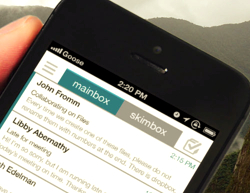Email solutions for the era of Information Overload

These days I’m hard at work on a major effort: I’m writing a white paper I call “Solutions to Information Overload: a Catalogue Raisonné”. It will be an encyclopedic compilation of every solution I know to Information Overload, from software to training tools, from behavior change drives to personal strategies, from commercial products to innovative ideas. And the more solutions I include, the more I find – there will likely be over 150 of them!
While many of the solutions I include have been around for a decade or more, I am delighted to observe the flood of brand new software tools, some still in beta, that attempt to help people cope with their overflowing inbox. But more than the quantity, I’m heartened by the nature of these new tools. You see, they indicate that email is – at last – growing up and disconnecting from its ancient roots. Email is adapting to the reality of communication in this new millennium!
Change is in the air!
Until a few years ago, we had email – the same old utility introduced in the early seventies and designed to allow Internet users to send text messages to each other on large terminals connected to mainframe computers. Sure, we no longer use mainframes, and messages can have attachments and images and whatnot, but the basic concept remained: you open your mail, you see an inbox with whatever messages have arrived, and you have to read and process them all – in an interface optimized for a large screen, keyboard and mouse. Sure, you could access your mail with a blackberry, though with far less convenience. Email was optimized for the desktop paradigm – and its design completely ignored the #1 aspect of this tool in today’s world: the insane overload that pushed us all into email hell.
All this is now beginning to change. Take, for example, one of those 150-odd solutions in my “Catalogue Raisonné”: Skimbox (previously called Gander). This is a good example of the new crop of email applications that are built from the ground up to be optimized for the reality of email in the new world of rampant communications, overload, and mobility. Skimbox is an email app for the iPhone that automatically sorts your incoming messages into two tabs: those you need to act on (“Mainbox”) and those you can just skim through, or ignore altogether (“Skimbox”). It uses your social graph, keyword cues, and past interactions with a sender to classify the messages, and learns to improve over time.
What’s different in the new solutions
And here is what I want to point out, vis-à-vis adaptation to the new reality of our times:
- A focus on Information Overload mitigation is built into the application’s tabbed home screen and key functionality, recognizing the critical need today’s users have for automated prioritization of messages. This is not an afterthought, or a retrofitted add-in: it’s the basis and raison d’être of the tool. It is even reflected in its name.
- Skimbox’s mobile-only interface goes beyond the half-hearted attempts of the previous decade to allow some measure of access to email on a tiny screen; it takes full advantage of the iPhone’s touch screen paradigm to unleash the strength of gesture based control: swipe right to mark a message as done; swipe left to defer it; tap to open or edit. No mouse, no menus… just a flick of the finger.
- The startup that makes Skimbox, Riparian Data, promises us a version that works with Exchange in an enterprise environment. Until now, there were mainly “old school” clients that worked with exchange, and innovative “new school” apps that worked with Gmail and its ilk. Skimbox will do both, because its makers recognize that large corporations have an even greater need for mobility and Information Overload mitigation than your typical Gmail user. And they seem willing to tackle the corporate stronghold, which is far harder to convert to new technology than iPhone-toting kids.
What does it mean for me and you?
We can expect to see more and more solutions in this space as vendors accept that email needs a major overhaul. Not all of them will succeed – Google Wave was one brave early attempt at a new email model that went too far, and failed. But there is no lack of explorers in this territory, and some will make it. As a result email will be better, overload will be less, and knowledge workers worldwide will have a better quality of life.
Of course, we too have a role to play… we must adopt the new tools, or they’ll disappear once their makers run out of their seed money. I’ve seen such cases too in my work on the Catalogue: amazing products that were there a year ago and have gone silent. To some extent this may be natural selection in action, but for those who make enterprise tools, it may simply be that driving new innovative IT products into corporations is a daunting task, as I know all too well. If you’re on the enterprise side of the fence, and want to promote the innovators while empowering your workforce with the most productive tool set, here is my take on how you can proceed. If you find this interesting, we can talk.
Let’s wish the innovators luck!


Excellent article as always Nathan! I’m with you – I wished more of the ‘new’ apps worked with corporate e-mail such as Exchange from the get-go. However, I’ve now signed up for Skimbox thanks to this post.
Looking forward to your white paper.
Joel Blaiberg
Product Manager
Dell Software Inc.